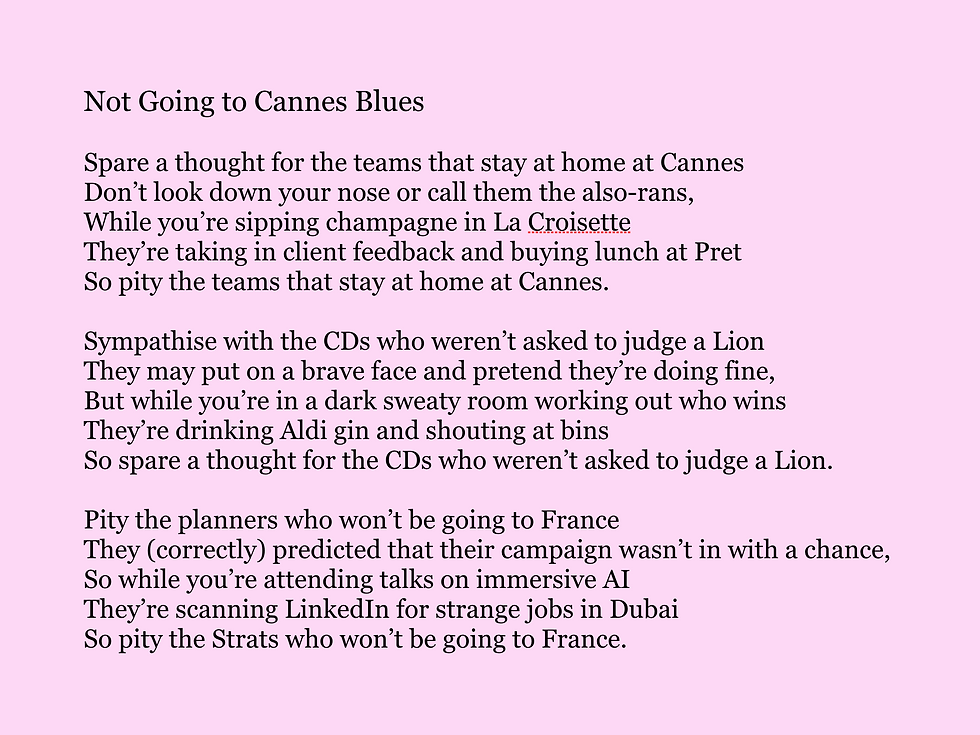Clear, Concise and Human
- Bill Dunn

- Jun 1, 2020
- 7 min read
How to write a Tone of Voice document in 10 not-very-easy steps.
“Just make it clear, concise and human.” That’s the default line I hear when I sit down to start building a Tone of Voice for a client’s company. If they’re feeling particularly jaunty that day, they may throw in “friendly”. None of this is particularly useful. Unless you’re working on some heavy-lifting comms for Emperor Palpatine’s new side hustle with Aleister Crowley, who doesn’t want to sound clear, concise, human and friendly?
If it were that easy, we could all walk away happy, job done, and your Tone of Voice document could fit on the back of a company branded Post-It Note.
But it’s not. And – at the calculated risk of revealing my trade secrets – here are the ten things I’d ideally do when creating a ToV document. Sometimes you end up doing about half of them, because of time/budget constraints. But hey, we’re professionals. We’ve got to aim high.
1) Start with the why
I don’t want to get all Simon Sinek-y, but this is vital. The best companies have a tone of voice that flows effortlessly from their point of view. And that point of view comes from the why. Knowing what the company stands for is the foundation of how it speaks. And often in mature companies it’s been buried under a slew of dusty files, dug out again and mangled beyond recognition in that afternoon session on the team building awayday in the New Forest, just before the 4pm raft-building bonding exercise. It’s the ToV artist’s job to find the why, dust it off, and see if everyone still loves it. Sometimes it’s been lost in an office move and you have to write it again yourself – and then tout it around again to make sure everyone agrees.
2) Talk to people who work there
I said “building” a Tone of Voice above. That was possibly the wrong word because it implies you’re doing it from scratch. A good ToV artist is more like a literate magpie, pouncing on and picking up the shiny good bits. And this process starts with a lot of coffees with the best people in the organisation. How do they speak? What do they think their company sounds like? It’s important to remember that you haven’t got free rein – you’re a guest in their organisation and you’re working on something that is very personal to them. I recently talked to 16 people in one company before I started work on its ToV document. Some were opinionated, some initially baffled about what I wanted. But those 16+ hours were well spent. The rest of it went really quickly after that because everyone felt involved.
3) Look at their best content
Examine forensically every bit of comms the company has ever made. Sure, it’ll be discordant, dissonant and at times cacophonous enough to make you weep tears of blood, but somewhere in there will be some crystal-clear gems that embody exactly how the company sounds at its very best. They might be hiding in plain sight on the “about us” section of the website, or they might be lurking in a pinned Instagram Story written by that bright work experience woman who came in two summers ago, but it’s our job to find them. They’ll inform our ToV later on.
4) Check the audience
Don’t try and write for everyone – just the people who matter. The people who are actually going to be the company’s potential customers. How old are they? Where do they live? What do they want from the company? Entertainment? Facts? A quick service? The best editors – and hence the best ToV artists – know their audience and instinctively write in language that chimes with that audience. It’s a fine balance, taking into consideration the character or gravitas of the company and how that fits with its audience. Take it too far and it’ll sound inauthentic, like you’re trying to be liked. That “groovy dad” neediness turns people off. On the other hand, trying to sell sportswear to Gen Zers talking like The Harvard Business Review is only going to end in tears.
5) Create a persona
This might sound daft but I’ve found it really works for me. Decide on a person/celebrity you know well who embodies the company. It could be a combination of people. How would she/he speak? How would they act in a certain situation? You might not want to share this with the client because it’s really divisive and can frighten the horses – but trying to think of everything a disembodied entity (the company) stands for can sometimes cause brain melt. Whereas thinking of it as, say, a combination of Angelina Jolie’s outspokenness and Robert Smith’s mordant wit can often crystallise how you think they’d talk.
6) Play with words
From your innumerable coffees talking to the key personnel you should now 1) be totally wired, and 2) have a long list of all the words that describe the company. Turn them into a massive word cloud on a whiteboard or InDesign document. That looks nice doesn’t it? But a bit mad. Have a herbal tea and sort them out into themed columns of key adjectives that reflect the company. That’s more like it. You should have three to five adjective headings and all the other words that are a bit like them underneath each heading. You’re beginning – finally – to get somewhere. Then start rewriting stuff based on these adjectives – any copy you find lying around that pertains to the company – and see what works and what doesn’t.
Here's The Week Junior's brand pillars taking shape. From a load of phrases here…

To some headlines we can hang everything off…

To the actual brand pillars…

7) Create some rules
From the above you should now be able to create some simple, easy-to-follow rules that you can give to anyone in the company who writes anything, from new hiring to CEO, press officer to head of social. These rules should empower everyone to write in a unified tone that truly embodies the company, adding authenticity and credence to everything it says at all touchpoints. I’d keep these rules to a minimum – no one can take in more than five. You’ll later turn these rules into a checklist that everyone can stick on the side of their screens so that when they’ve written something they can quickly and easily see if it’s on tone.
8) Lead by example
Rules are everywhere and people don’t like them – they prefer real-world examples.“Be immediate” means very little to a non-writer. Likewise “avoid gerunds because they slow everything down and stop your writing from being immediate” isn’t going to change anyone’s writing behaviour. Instead, create some examples that will inspire people into writing in the ToV. Show, don’t tell. You might show a “before/bad” and an “after/good” example like: “Empowering cats to climb” and “We empower cats to climb”. Everyone gets that.
*NB1: I’ve sometimes been asked to provide examples of prescriptive things like email templates and even a full house style document. Don’t try to squeeze these bulky beasts into your ToV document – it’ll ruin the internal logic and flow. Put them at the end, in a glossary.
*NB2: At some point here you’re inevitably going to stray from ToV into content. The ToV will start creating content of its own, like a Sci-fi lab experiment that’s got out of control. Resist this at all costs, whatever the temptation to write new stuff, or people will be too busy judging the new content to take in the ToV rule example. Use existing content and rewrite that with your new ToV rules, even if the person who wrote it is still in the building, scowling behind your back and plotting your imminent demise.
9) Look at it with the visuals
Oh, did I say that ideally you should be writing this ToV document sitting next to the art director who is rebranding the company visually? Well you should. But in my experience it’s only happened that way a handful of times, usually with my colleague Ash Gibson, who has as much to say about words as I have to say about his design. If it doesn’t, don’t worry. Us lowly ToV monkeys are like bass players – barely noticed over the lead guitar art wizardry of the graphic designers who’ve gone in, done their stuff and got out again to rapturous applause. But once you’ve got your ToV and examples worked out, it’s good to put your copy on a dummy company website, or underneath the logo, or working on trial social posts. Just to check if your new words of wisdom aren't tangentially at odds with the look and feel of the visuals.
10) Roll it out
At this point you should now have two documents – a larger “project” one that explains all your thinking from the why, to the research, to the rules and the examples. This is for the CMO to take to his CFO and CEO to justify all your time and coffee receipts. Then there should be a short, concise version that is your objective. This is for everyone else – the staff, stakeholders, agencies and freelancers who are actually going to have to use it. They don’t want to hear about your airy-fairy thinking – they’ve got real work to get on with.
But your job’s not over yet – now you’ve got to get people to use it. When I did Volvo’s Tone of Voice, I chaired seminars with everyone from the marketing department to external agencies. Diplomacy is king here – you don’t want to sound too doctrinaire. Most people like to think they’re good writers, just like most people like to think they’re good at sex, and on no account do you want to make them feel that what they’ve been doing for the last few years has been tragically and painfully wrong. So treat it like a discussion, involve people, be open, listen to them and get them to bring along stuff they’ve written or want to write, and see if the new Tone of Voice you’ve created makes it better. If it does, your work is done.
Bill Dunn has devised Tone of Voice for clients including Volvo Car Corporation, Cannes Lions, The Week, The Week Junior, MoneyWeek and the Wiggin legal firm. He’d love to share these documents with you but is bound by confidentiality not to. (And anyway, you’d probably just copy them, then cut and paste “clear”, “concise” and “human” into the relevant sections.)



Comments